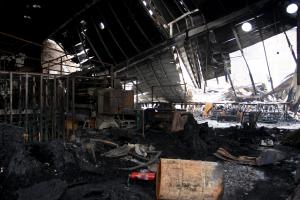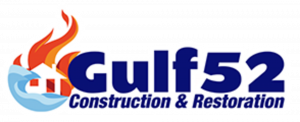Clarifying the Insurance Claims Process for Water, Fire, and Mold Damage
Earl Carr, Jr., president of Gulf 52 in Hammond, Louisiana, explains the importance of navigating the insurance claims process methodically and with a documented approach.
“Disasters introduce both physical and administrative challenges,” said Carr. “A claim’s success depends heavily on how quickly damage is reported, how thoroughly it’s documented, and how clearly it’s communicated to the insurance provider.”
Initial Response: Immediate Action and Documentation
The first step in the claims process begins with protecting the property from further damage. This may involve stopping water intrusion, boarding up exposed areas after fire damage, or sealing off mold-contaminated zones. Most insurance policies include a clause requiring “reasonable steps” be taken to prevent additional loss, and failure to do so may impact coverage.
Accurate documentation is critical at this stage. This includes:
Photographs of the affected areas from multiple angles
Video walkthroughs capturing the full scope of the damage
Written notes describing the condition of contents, structures, and utilities
Records of any emergency mitigation services or cleanup performed
This initial evidence provides the foundation for the claim and ensures no detail is lost once repairs begin.
Filing the Claim: Timing and Accuracy
Once the situation is stabilized, the insurance carrier should be notified. The claim should include all available documentation along with a detailed description of the event. Most policies specify a time frame for reporting the loss—delays can result in reduced compensation or claim denial.
During the filing process, a claim number will be issued, and an adjuster will be assigned to investigate the loss. Policyholders should keep copies of all communications with the carrier, including emails, letters, and call logs, to maintain a clear record of the process.
Adjuster Inspection and Damage Assessment
An insurance adjuster will schedule an on-site inspection to assess the extent of the damage and determine how much of it is covered under the policy. The adjuster may bring third-party specialists, such as engineers or environmental hygienists, particularly in mold claims where health risk assessments are required.
It is important for the damage to remain visible during this inspection. Premature removal of affected materials or belongings can complicate the adjuster’s ability to confirm the extent of the loss.
After the inspection, the adjuster will generate a report outlining recommended compensation. This report becomes the basis for the claim payout.
Understanding Coverage Limitations
Insurance policies often contain different coverage sections for water, fire, and mold. These categories may be subject to separate limits, exclusions, or endorsements.
Water Damage: Coverage varies depending on the source. Sudden pipe bursts are often covered, while damage from long-term leaks or floodwaters may be excluded or fall under a separate flood policy.
Fire Damage: Structural and contents damage from flames, smoke, and extinguishing efforts are typically covered under most standard property insurance plans. Some policies also include additional living expenses for temporary relocation.
Mold Damage: Coverage for mold is often limited and may require specific endorsements. Mold caused by a covered water loss is more likely to be eligible for compensation than mold resulting from ongoing maintenance issues.
Thorough policy review is essential before proceeding with restoration to avoid unexpected expenses that fall outside the scope of the policy.
Contractor Coordination and Estimates
After the claim is initiated and inspected, restoration professionals may be brought in to provide repair estimates. Multiple estimates are often recommended to confirm pricing and scope. The selected contractor should be experienced in insurance restoration and familiar with the claims process.
In many cases, the insurance company will use pricing software to determine “reasonable” repair costs. Discrepancies between contractor estimates and the insurer’s pricing may lead to negotiation. Documentation from the contractor—including itemized estimates, justifications for material choices, and timelines—can support these discussions.
Payment Process and Project Oversight
Once the claim is approved, the insurance company will issue payment either directly to the policyholder or to the mortgage company holding interest in the property. Some payments are disbursed in stages—initial funds for emergency work and a final check upon project completion.
Restoration progress should be monitored and documented throughout. Before final payment is released, a detailed review of completed work and verification against the insurance scope is recommended.
Finalizing the Claim
Upon completion of repairs, a final walkthrough may be performed with the contractor and adjuster to confirm the work was completed in accordance with the claim. Any discrepancies should be resolved prior to closing the file.
It is advisable to retain all records, including receipts, photographs, communications, and contractor documents, for future reference. In the event of a dispute or future damage, these records provide critical historical information.
Morgan Thomas
Rhino Digital, LLC
+1 504-875-5036
email us here
Visit us on social media:
Facebook
Legal Disclaimer:
EIN Presswire provides this news content "as is" without warranty of any kind. We do not accept any responsibility or liability for the accuracy, content, images, videos, licenses, completeness, legality, or reliability of the information contained in this article. If you have any complaints or copyright issues related to this article, kindly contact the author above.
Royal Cyber Launches AgenticAI – The Autonomous Framework Powering the Future of Intelligent Digital Commerce
The Dairy Alliance Celebrates National Ice Cream Day
Tulua Aesthetics Partners with DoctorLogic to Achieve 10X Online Visibility in Just 8 Months
Kalendarium
Więcej ważnych informacji
 Jedynka Newserii
Jedynka Newserii

 Jedynka Newserii
Jedynka Newserii

Bankowość

Banki spółdzielcze coraz ważniejsze dla finansowania gospodarki. Współpraca z BGK ma pobudzić lokalne inwestycje
Banki spółdzielcze w coraz większym stopniu odpowiadają za finansowanie rozwoju gospodarki. Ich udział w ostatnich latach wzrósł, a kondycja sektora się poprawiła. Bank Gospodarstwa Krajowego chce wzmocnić współpracę z bankami spółdzielczymi na rzecz finansowania lokalnego rozwoju. To jeden z elementów nowej strategii BGK na lata 2025–2030. Narzędziami, które do tego służą, są gwarancje BGK.
Prawo
Przedstawienie projektu przez KE oznacza początek dyskusji nad nowym siedmioletnim budżetem. W PE zdania co do jego kształtu są podzielone

16 lipca br. Komisja Europejska przedstawi propozycję wieloletnich ram finansowych. To będzie dopiero początek wytężonych prac nad kształtem nowego budżetu i trudnych dyskusji na ten temat, bo wśród państw członkowskich, ale też w różnych frakcjach parlamentarnych jest wiele różnic dotyczących szczegółowych rozwiązań. Chodzi m.in. o podejście do wspólnego zadłużania się, nowych źródeł zasobów UE czy rozszerzania kompetencji UE.
Konsument
Konflikty i żywioły wpływają na wakacyjne plany Polaków. Bezpieczeństwo coraz ważniejsze przy wyborze letniej destynacji

Sytuacja geopolityczna i pogodowa sprawia, że Polacy coraz rozważniej podchodzą do wyboru wakacyjnych kierunków. Choć nieprzewidziane zdarzenia mogą się zdarzyć w każdym miejscu na świecie, to minimalizowaniu ryzyka służą m.in. sprawdzanie ostrzeżeń dla podróżnych na stronach Ministerstwa Spraw Zagranicznych, rejestracja w systemie Odyseusz, który zadziała w razie kryzysowej sytuacji, a także wyjazd z ubezpieczeniem turystycznym. Koszty ewentualnego leczenia czy repatriacji znacząco przewyższają bowiem wysokość składki.
Partner serwisu
Szkolenia

Akademia Newserii
Akademia Newserii to projekt, w ramach którego najlepsi polscy dziennikarze biznesowi, giełdowi oraz lifestylowi, a także szkoleniowcy z wieloletnim doświadczeniem dzielą się swoją wiedzą nt. pracy z mediami.









.gif)

 |
| |
| |
|